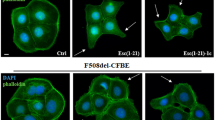Abstract
Antimicrobial peptides are evolutionary components of the immune system generated in response to microbial infections. Human catestatin CgA352–372 (SL-21) is an endogenous neuropeptide with multiple biological functions. The present study aimed to further evaluate the immunomodulatory role of SL-21 in innate immunity of lung cells and investigate its impact on the expression level of pro-inflammatory factors. SL-21 neuropeptide, generated from the C-terminus of chromogranin A, was first chemically synthesized by solid-phase method and purified using C8 semi-preparative RP-HPLC. According to the results of MTT assay, SL-21 showed no significant cytotoxicity effect on human lung epithelial adenocarcinoma cell line (A549) and human fetal lung fibroblast primary cells even at high concentration (<12 % suppression of the cell growth). Furthermore, SL-21 decreased the expression level of pro-inflammatory factors including interleukine-1β (IL-1β), IL-6, IL-8, and tumor necrosis factor-α in a dose- and time-dependent manner. The results suggest that SL-21 antimicrobial neuropeptide interferes with cytokine network evolving during inflammatory processes of the respiratory tract. Since inflammation has been implicated as one of the main causative factors in human diseases, our findings suggest that potent SL-21 anti-inflammatory properties could be of great significance in the treatment of inflammatory disorders.



Similar content being viewed by others
References
Ahn CB, Je JY, Cho YS (2012) Antioxidant and anti-inflammatory peptide fraction from salmon byproduct protein hydrolysates by peptic hydrolysis. Food Res Int 49:92–98
Aung G, Niyonsaba F, Ushio H, Hoq MI, Ikeda S, Ogawa H, Okumura K (2011) A neuroendocrine antimicrobial peptide, catestatin, stimulates interleukin-8 production from human keratinocytes via activation of mitogen-activated protein kinases. J Dermatol Sci 61:129–150
Auvynet C, Rosenstein Y (2009) Multifunctional host defense peptides: antimicrobial peptides, the small yet big players in innate and adaptive immunity. FEBS J 276:6497–6508
Baranek T, Debret R, Antonicelli F, Lamkhioued B, Belaaouaj A, Hornebeck W, Bernard P, Guenounou M, Le Naour R (2007) Elastin receptor (spliced galactosidase) occupancy by elastin peptides counteracts proinflammatory cytokine expression in lipopolysaccharide-stimulated human monocytes through NF-B down-regulation. J Immunol 179:6184–6192
Bertazza L, Mocellin S (2008) Tumor necrosis factor (TNF) biology and cell death. Front Biosci 13:2736–2743
El Karim IA, Linden GJ, Orr DF, Lundy FT (2008) Antimicrobial activity of neuropeptides against a range of micro-organisms from skin, oral, respiratory and gastrointestinal tract sites. J Neuroimmunol 200:11–16
Ghavami S, Asoodeh A, Klonisch T, Halayko AJ, Kadkhoda K, Kroczak TJ, Gibson SB, Booy EP, Naderi-Manesh H, Los M (2008) Brevinin-2R semi-selectively kills cancer cells by a distinct mechanism, which involves the lysosomal-mitochondrial death pathway. J Cell Mol Med 12:1005–1022
Hancock REW (2001) Cationic peptides: effectors in innate immunity and novel antimicrobials. Lancet Infect Dis 1:156–164
Hernández-Ledesma B, Hsieh CC, de Lumen BO (2009) Antioxidant and anti-inflammatory properties of cancer preventive peptide lunasin in RAW 264.7 macrophages. Biochem Biophys Res Commun 390:803–808
Hoq MI, Niyonsaba F, Ushio H, Aung G, Okumura K, Ogawa H (2011) Human catestatin enhances migration and proliferation of normal humanepidermal keratinocytes. J Dermatol Sci 64:108–118
Kolls JK, McCray PB Jr, Chan YR (2008) Cytokine-mediated regulation of antimicrobial proteins. Nat Rev Immunol 8:829–835
MacRedmond R, Greene CC, Taggart N, McElvaney O’Neill S (2005) Respiratory epithelial cells require toll-like receptor 4 for induction of human β-defensin 2 by lipopolysaccharide. Respir Res 6:111–116
Mahata SK, Mahata M, Fung MM, O’Connor DT (2010) Catestatin: a multifunctional peptide from chromogranin A. Regul Pept 165:52–62
Mohseni S, Emtenani S, Emtenani S, Asoodeh A (2014) Antioxidant properties of a human neuropeptideand its protective effect on free radical-induced DNA damage. J Pept Sci 20:429–437
Mookherjee N, Brown KL, Bowdish DM, Doria S, Falsafi R, Hokamp K, Roche FM, Mu R, Doho GH, Pistolic J, Powers JP, Bryan J, Brinkman FS, Hancock RE (2006) Modulation of the TLR-mediated inflammatory response by the endogenous human host defense peptide LL-37. J Immunol 176:2455–2464
Pistolic J, Cosseau C, Li Y, Yu JJ, Filewod NC, Gellatly S, Rehaume LM, Bowdish DM, Hancock RE (2009) Host defence peptide LL-37 induces IL-6 expression in human bronchial epithelial cells by activation of the NF-κB signaling pathway. J Innate Immun 1:254–267
Radek KA, Lopez-Garcia B, Hupe M, Niesman IR, Elias PM, Taupenot L, Mahata SK, O’Connor DT, Gallo RL (2008) The neuroendocrine peptide catestatin is a cutaneous antimicrobial and induced in the skin after injury. J Invest Dermatol 128:1525–1534
Takahashi D, Shukla SK, Prakash O, Zhang G (2010) Structural determinants of host defense peptides for antimicrobial activity and target cell selectivity. Biochimie 92:1236–1241
Wang Z, Jiang W, Zhang Z, Qian M, Du B (2012) Nitidine chloride inhibits LPS-induced inflammatory cytokines production via MAPK and NF-kappa B pathway in RAW 264.7 cells. J Ethnopharmacol 144:145–150
Acknowledgments
This work was supported by Ferdowsi University of Mashhad, and Zabol University of Medical Sciences, therefore is greatly appreciated by the authors. We would like also to thank from Khadije Rezaie-Keikhaie, Mohammad Reza Abbaszadegan and Mehran Gholamin for reading the manuscript.
Conflict of interest
Kolsoum Rezaie-Kahkhaie, Shirin Emtenani, Shamsi Emtenani, Doosti, Mohammad, and Ahmad Asoodeh declare that they have no conflict of interest.
Human and Animal Rights and Informed Consent
This article does not contain any studies with human or animal subjects performed by any of the authors.
Author information
Authors and Affiliations
Corresponding author
Rights and permissions
About this article
Cite this article
Rezaie-Kahkhaie, K., Emtenani, S., Emtenani, S. et al. The Effect of a Human Antibacterial Neuropeptide SL-21 on the Expression of Pro-inflammatory Factors in Airway Epithelial Cells. Int J Pept Res Ther 21, 403–409 (2015). https://doi.org/10.1007/s10989-015-9469-5
Accepted:
Published:
Issue Date:
DOI: https://doi.org/10.1007/s10989-015-9469-5




